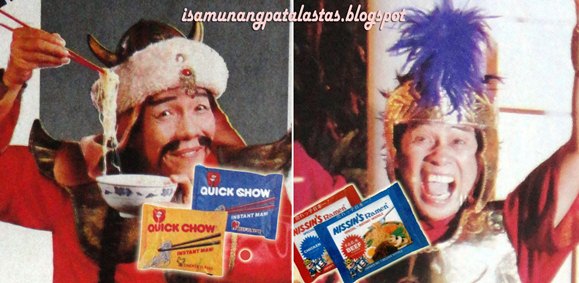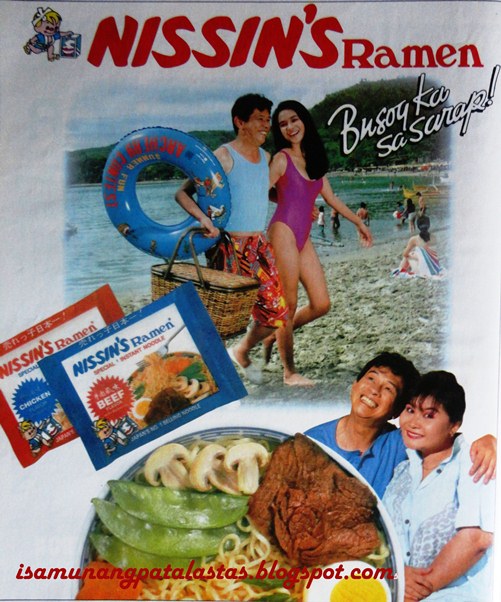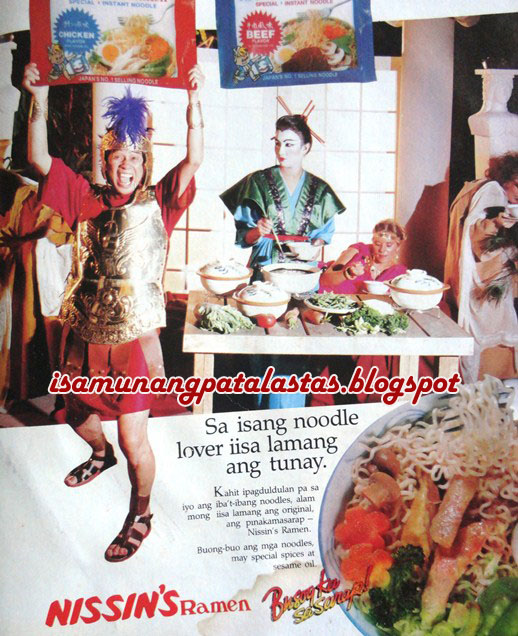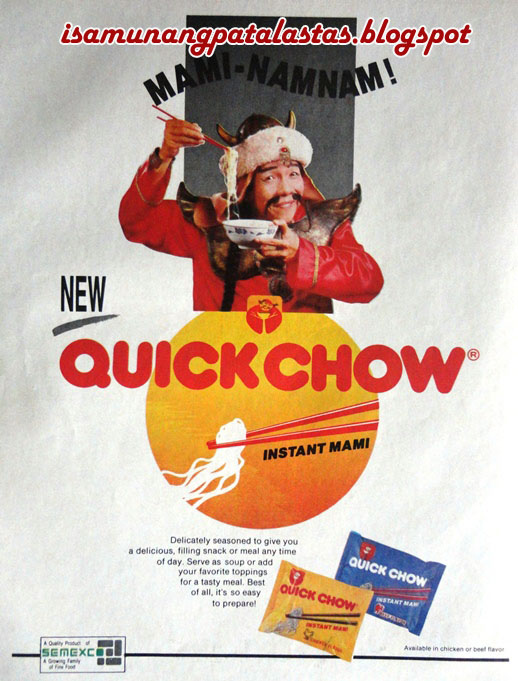Before, preparing noodle soups and dishes was a chore:
one had to get fresh noodles or dry bihon
from the market, cooked at home, garnished with vegetables and flavor-enriched
with spices and condiments. You can also buy Royal Continental chicken noodles in packs (Royco), but they take awhile to cook. The other option was to buy from a suking mamihan or panciteria.
The creation of the world’s first instant noodles in 1958
by Taiwanese-Japanese Momofuku Ando in Japan changed all that. His company,
Nissin, invented a process of flash-frying noodles after they have been made, giving
birth to the “instant noodles”. His first product was Chicken Ramen.
In many countries, including the Philippines, instant
noodles in individual packs have become basic food items for almost all households—tasty,
easy to prepare, and so affordable. But it would take decades before Japan’s
best-selling noodles would be introduced to the Philippines.
At first, NISSIN’S
RAMEN was imported from Japan, and then distributed in outlets –groceries and
supermarkets—packed in their distinctive red (chicken) and blue (beef) pouches with Japanese scripts. The flavorful NISSIN’S RAMEN became an instant hit among
Filipinos, and by the 1980s, the brand was actively advertising in newspaers
and magazine.
The first NISSIN’S
RAMEN ads that featured a celebrity were launched in 1987, starring the irrepressible
Gary Lising, the “Bob Hope” of the Philippines, who helped popularized the
American stand-up comedy style of entertainment. The Ateneo graduate wrote and
performed his own (green) material in zany comedy show “Champoy” aired on
Channel 9. Pretty soon, he was appearing in scores of movies (‘Wander Woman si
Ako”, “Erpats Kung Forgets”, “Run Barbi Run”, etc.). Lising appeared as the main presenter of NISSIN'S RAMEN under the "Busog ka sa Sarap" campaign theme.
WATCH GARY LISING BACK ON STAGE HERE IN SHANG-RILA HERE:
uploaded by Herminio Mendiola
The windfall success
of NISSIN’S RAMEN prompted other
companies to branch out to noodle production after realizing the potential of
the noodle market. Lucky Me! was introduced in 1989 by biscuit company, Monde,
and would give NISSIN’S RAMEN stiff
competition. The next year, Semexco Marketing Corp., which already had a winner
with its beverage, Zest-O Juice Drink,
joined the noodle bandwagon in 1990 with the launch of QUICKCHOW.
QUICKCHOW laid
claim to being “the first brand to
introduce rice noodles”, and made
headway in the market, capturing the Southern Philippine market that propelled
it to third place nationally.
Helping push QUICKCHOW
was the versatile JUN URBANO, who
used his very popular “Mr. Shooli” character in the launch ads for the noodle
brand in 1990. Urbano, the son of actor-director Manuel Conde, had his start in
advertising as a hugely successful commercial director, megging many classic
San Miguel Beer ads in the 80s.
In 1985, he created and portrayed the character
“Mr. Shoo-li” who first appeared in “Not So Late Night with Edu”. His satirical political commentaries delivered in his
signature Chinese accent became a certified TV hit. This led to his own talk
show, “Mongolian Babecue”. In 1991, he even starred in a film, “Juan Tamad at
Mr. Shooli: Mongolian Barbecue”.
WATCH MR. SHOOLI' s PERFORMANCE HERE:
Source: GMA Network
Today, the noodle brands that Gary Lising and Jun Urbano
endorsed are still going on strong. NISSIN’S
partnered with URC in 1996 to form Nissin
Universal Robina Corp. in the Philippines which now produces local NISSIN’S noodles, including cup noodles,
yakisoba, and Payless. QUICKCHOW can
still be enjoyed in these delicious varieties: palabok, pancit canton, toyomansi, guisado, La Paz batchoy.
However, Lucky Me! ! is the undisputed no. 1 instant noodle brand in the
country, which incidentally has also tied up with NISSIN to become Monde Nissin
Corp.
As to Gary Lising
and Jun Urbano, there is no
competition beyond their product endorsements. They are, in fact, good friends,
who first met as Ateneo students in
1961. They worked together in films like “M.O.N.A.Y. (Misteyks obda neyson adres Yata) ni Mr. Shooli” (1991), and most
recently in “Ibong Adarna” (2014), which Urbano directed. Lising had a health
setback in 2009, but recovered and bounced with help from his colleagues in the
industry,
SOURCES:
Nissin’s Food group
website: https://www.nissin.com/en_jp/about/history/
Gary Lising: Wikipedia.com
Minde Nissin
website: https://www.mondenissin.com/
Uncovering Jun
Urbano, by Euden Valdez, 14 Jun. 2014:
MR. SHOOLI IS BACK: https://www.youtube.com/watch?v=VP3ZP3TOktU, uploaded by GMA Network, Oct. 7, 2014.
GARY LISING BACK ON STAGE AT SHANGRILA EDSA, https://www.youtube.com/watch?v=ZMEb1jsNuic&t=13s,
posted by
Herminio Mendiola, Published on Oct 24, 2012,











































